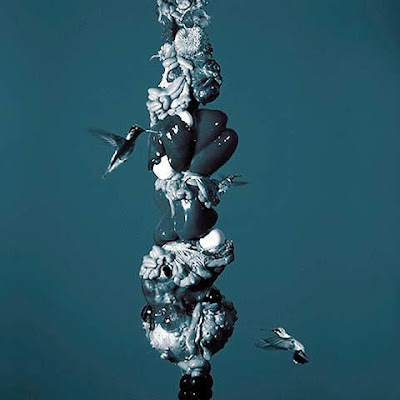Edgar Allan Poe believed that checkers is a more profound game than chess. The rules of checkers are extremely simple, he wrote, but their simplicity opens the game up to psychology and reflection while chess remains a closed game of complex mathematical combinations: "The higher powers of the reflective intellect are more decidedly and more usefully tasked by [checkers] than by all the elaborate frivolity of chess [where] what is only complex is mistaken...for what is profound."
After 68 years, Archie Andrews (the world's most indecisive guy) has finally chosen Veronica Lodge over Betty Cooper.

He marries Veronica in the current issue of Archie (no. 601).

Now is probably a good time to reflect upon-- and honor-- the seven decades that Betty and Veronica spent in purgatory as they tried to persuade this lout to commit. Day and night the two girls schemed and competed, connived and begged without success. This had to be a frustrating life and, as the decades went by, an ultimately debasing one. But the girls were trapped in a loop; they were never permitted to graduate from high school and mature into women with the confidence and self-respect to walk away. Thus, the parable of Betty and Veronica became a demented combination of Ground Hog Day and the Myth of Sisyphus.

The fateful moment Betty met Archie (1941). How could she know she was at the threshold of 68 years of indecision and disappointment?
Ultimately, the girls received mercy not from their writers or artists but from the marketplace-- dwindling circulation numbers and advertising revenues accomplished what the two girls could not: it finally squeezed a commitment out of Archie (assuming of course that these were not androids getting married, in which case the cruel jest continues).
You can fill in the gaps yourself regarding what took place during this long, long struggle. Each time Betty or Veronica was hungry for dessert, did she pause to consider whether gaining weight might give her rival a competitive advantage? How many ice cream sodas did Betty forego in 68 long years to make herself more attractive to that vacillating wretch Archie? And how do you calculate the toll on the human spirit of seven decades of doubt and guilt?
Then there's the huge disparity in wealth between rich Veronica and middle class Betty. At first, this would seem to make their competition as uneven as a competition between a rook and a pawn. But psychological advantages are not so cleanly divided. Veronica will live every day uncertain whether her father's wealth, and not her personal qualities, made the crucial difference to Archie. (That same uncertainty will probably help to console the vanquished Betty.) What does this portend for the marriage? Well, ask yourself: will the witless Archie be sensitive to the causes of a rich girl's insecurity? Is he capable of reassuring her in a way that will keep doubt from gnawing at her (and surfacing in a thousand little tests and spats)? Will she eventually seek reassurance in alcohol? Or in the arms of the gardener?
While you are filling in the gaps, consider the sexual favors the two girls must have surrendered in Archie's old jalopy. If each girl felt pressure to go further than she had on the previous date, how far did she have to go to keep the insatiable Archie intrigued after 68 years of dating? Even worse, each girl had to struggle with the pressure of what their rival might be offering the selfish boy on the following night, and perform accordingly.

This is not the type of straightforward competition won by the girl most successful at gratifying Archie's lusts. Archie himself was a simpleton, but the gamesmanship of their triangle must have been more complicated than 3 dimensional chess. The creators have not disclosed Archie's vile sexual preferences, but they did occasionally share his method of sweet talking his vulnerable girlfriends:



By constructing Archie as a cipher, the creators enabled readers to fill the vacuum with their own speculation. Readers get to decide: would an old fashioned boy such as Archie feel obligated to marry the first girl who gave him sex? Or would he feel uncomfortable committing to a girl who capitulated too quickly? Most likely, he'd be intimidated by a girl who seemed more hot blooded than he was. Betty and Veronica also had to weigh whether Archie was so clueless and self-absorbed that he might be unaware of the commitment they were expressing through sex. What if they sacrificed for him and he was just too oblivious to reciprocate? With stakes so high, what was the best course of action for the girls? They had many long nights to fret about this during 70 years of high school.

The art of Archie started out at the bare minimum quality level and frequently went downhill from there. But the art, like the character, was a basic checker piece, an empty vessel that could be filled with all kinds of content such as the embellishments offered above. If the creators ever began to fill in the gaps in the story or the art ever became more insightful-- or at least more committal-- then some of my speculation might have been ruled out. Archie, Betty and Veronica would have been converted from checkers into chess pieces with defined roles . But of course, then some of the implicit horror of their relationships might have begun to show through.
The ancient Romans tied clown masks on the Christian martyrs so that, as they perished in the jaws of the lions in the Coliseum, they were denied the dignity of their faces. Perhaps the cheerful vacuous templates frozen on the faces of Betty and Veronica (who are now blessedly released from their long martyrdom) were conceived with the same purpose.
Read more "ARCHIE MARRIES VERONICA..."























































